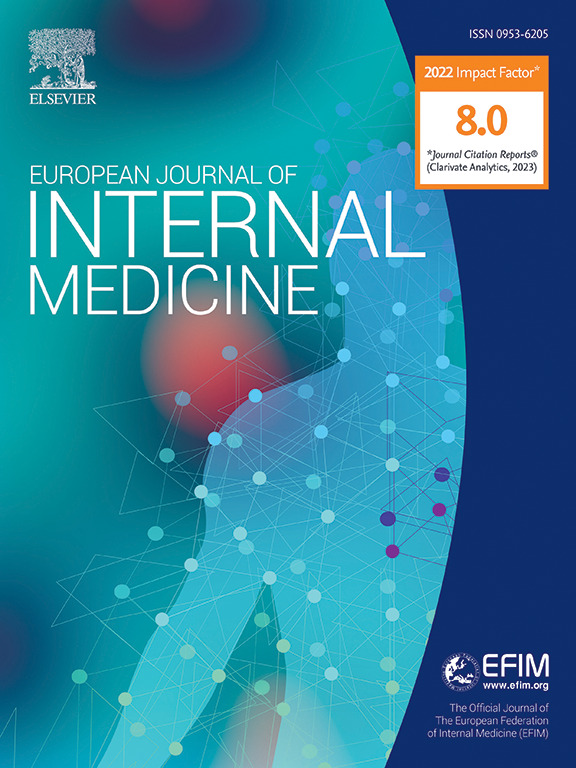Prognostic impact of uric acid levels in heart failure with mildly reduced ejection fraction: Insights from a large retrospective registry
IF 6.1
2区 医学
Q1 MEDICINE, GENERAL & INTERNAL
引用次数: 0
Abstract
Background
Elevated uric acid (UA) is a recognized biomarker in patients with cardiovascular disease. However, the prognostic significance of UA levels in patients with heart failure (HF), particularly those with HF with mildly reduced ejection fraction (HFmrEF), remains unexplored.
Methods
From 2016 to 2022, consecutive patients hospitalized with HFmrEF at one medical centre were retrospectively included. Patients were stratified by pre-specified UA levels (i.e., normal UA: ≥3.5 - ≤6.0 (females) or ≤7.0 (males); low UA: <3.5 and high UA: >6.0 (females) or >7.0 mg/dL (males)), further stratification was performed by UA quintiles. The primary endpoint was all-cause mortality at 30 months (median follow-up), the key secondary endpoint was HF-related rehospitalization.
Results
The study cohort comprised 1419 HFmrEF patients with a median UA of 6.0mg/dL. UA levels above (H) and below (L) the normal range (N) were predictive for the risk of all-cause mortality at 30 months (H: 42 % and L: 43 % vs. N: 27 %), which persisted after multivariable adjustments (H vs N: HR=1.230; 95 % CI 1.003–1.508; p = 0.046; L vs N: HR=1.915; 95 % CI 1.383–2.650; p = 0.001). Furthermore, there was a trend towards a higher risk of long-term HF-related rehospitalization in patients with elevated UA levels (H: 20 % vs. N: 9 % vs. L: 8 %). However, this finding failed to reach statistical significance after multivariable adjustment (H vs. N: HR=1.408; 95 % CI 0.995–1.992; p = 0.053).
Conclusion
Both elevated and low UA levels were associated with an increased risk of long-term all-cause mortality in patients with HFmrEF.
尿酸水平对心力衰竭伴轻度射血分数降低的预后影响:来自大型回顾性登记的见解。
背景:尿酸升高(UA)是心血管疾病患者公认的生物标志物。然而,UA水平对心力衰竭(HF)患者的预后意义,特别是那些伴有轻度射血分数降低(HFmrEF)的心力衰竭患者的预后意义仍未得到探讨。方法:回顾性分析2016年至2022年在同一医疗中心连续住院的HFmrEF患者。患者按预先指定的UA水平分层(即正常UA:≥3.5 -≤6.0(女性)或≤7.0(男性);低UA: 6.0(女性)或>7.0 mg/dL(男性)),进一步分层UA五分位数。主要终点是30个月时的全因死亡率(中位随访),关键的次要终点是hf相关的再住院。结果:研究队列包括1419例HFmrEF患者,中位UA为6.0mg/dL。高于(H)和低于(L)正常范围(N)的UA水平可预测30个月时全因死亡的风险(H: 42 %和L: 43 % vs. N: 27 %),在多变量调整后仍然存在(H vs N: HR=1.230;95 % ci 1.003-1.508;P = 0.046;L vs N: HR=1.915;95 % ci 1.383-2.650;P = 0.001)。此外,UA水平升高的患者长期hf相关再住院的风险更高(H: 20 % vs. N: 9 % vs. L: 8 %)。但经多变量调整后,这一发现未达到统计学意义(H vs. N: HR=1.408;95 % ci 0.995-1.992;P = 0.053)。结论:高UA和低UA水平均与HFmrEF患者长期全因死亡风险增加相关。
本文章由计算机程序翻译,如有差异,请以英文原文为准。
求助全文
约1分钟内获得全文
求助全文
来源期刊
CiteScore
9.60
自引率
6.20%
发文量
364
审稿时长
20 days
期刊介绍:
The European Journal of Internal Medicine serves as the official journal of the European Federation of Internal Medicine and is the primary scientific reference for European academic and non-academic internists. It is dedicated to advancing science and practice in internal medicine across Europe. The journal publishes original articles, editorials, reviews, internal medicine flashcards, and other relevant information in the field. Both translational medicine and clinical studies are emphasized. EJIM aspires to be a leading platform for excellent clinical studies, with a focus on enhancing the quality of healthcare in European hospitals.

 求助内容:
求助内容: 应助结果提醒方式:
应助结果提醒方式:


